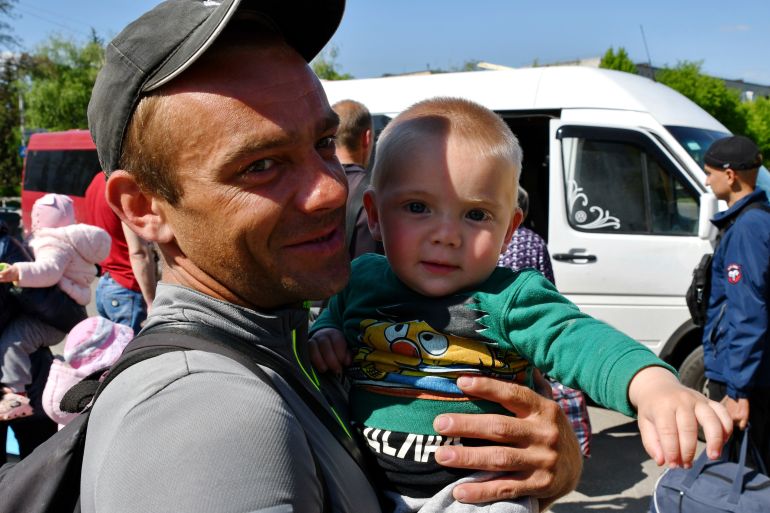Ukrainians fleeing war try different ways to enter the US
Ukrainians are coming to the US on tourist visas, through the southern border or under a new sponsorship programme.

Around 14,500 Ukrainians have filed for applications as of last week to come to the United States under a humanitarian parole programme that allows Ukrainians to stay with American sponsors.
The administration of US President Joe Biden expects most Ukrainians whose lives have been upended by Russia’s invasion of their country to stay in Europe. But in March, his administration announced that it would expect up to 100,000 to stay and work in the US for up to two years.
Keep reading
list of 3 itemsUS-Cuba tensions persist after high-level migration talks
Biden talks with Mexico’s AMLO to discuss migration, Ukraine
The “Uniting for Ukraine” programme was unrolled on April 25 and potential sponsors must upload details about their employment and assets. Applicants must pass identity and security checks before they can travel to the US and be considered for enrollment.
The "Uniting for Ukraine" program provides a streamlined process for displaced Ukrainian citizens and their immediate family members who are outside the United States to come to the United States and stay temporarily for up to two years. https://t.co/ivatxwIgaA
— Baker Donelson (@Baker_Donelson) May 9, 2022
The programme to assist Ukrainians fleeing war comes amid continued pressure on the Biden administration to allocate more military aid to Ukraine, and issue more sanctions against Russia. According to the United Nations, more than 5.8 million Ukrainians have fled their country since the February 24 invasion.
On March 3, the US Department of Homeland Security (DHS) announced that it would be extending temporary protected status to Ukrainians already in the country for 18 months.
The Uniting for Ukraine programme has given Iryna Bashynskyy of Portland, Oregon, hope. Since February, Bashynskyy has been looking for ways to get her niece, Yana, out of Ukraine. Now, Bashynskyy is gathering documents, including her tax returns and bank statements.
“It’s a hustle,” Bashynskyy told Reuters. “But I’ll try to accomplish it.”
Yana asked to only be identified by her first name due to safety concerns.
“It is necessary to somehow escape from here,” Yana, 23, said through a translator from her apartment in Kyiv. “I’m scared about my life, about my future. Because you don’t know where a bomb will drop, at what time, and what will happen.”
New York-based attorney Marina Shepelsky has been receiving hundreds of calls from people with relatives in Ukraine. For the first month and a half of the Russian invasion, Shepelsky – a Ukrainian refugee herself whose family fled the Soviet Union in 1989 – was advising them to apply for tourist visas.
“Now I’m kind of discouraging it,” Shepelsky said, saying Uniting for Ukraine offers “a better status”.
Nearly 3,500 Ukrainians were issued temporary US visas for tourism or business in March, up sharply from about 900 in February, according to US Department of State statistics.
Many Ukrainians had also been flying to Mexico and claiming asylum at the US-Mexico border by land.
Despite a coronavirus pandemic-era restriction in place, the US allowed hundreds of Ukrainians to apply for asylum at the border, drawing rebuke from rights groups who denounced the fact that asylum seekers from other nationalities were being turned away, and shining a light on what Ukrainians said was a complicated legal process to bring people into the US.
DHS said that as of April 25, when Uniting for Ukraine went live, Ukrainians at the southwest border who did not have valid visas or pre-authorisation to travel to the US through Uniting for Ukraine could be denied entry.
The Associated Press reported last week that some refugees who arrived at the US border in Tijuana were told they would no longer be admitted.
Leonard Mogul is seeking a spousal immigration visa for the woman he married in a non-denominational, 30-minute Zoom wedding in early March. Her wedding band was a ring he had bought her during a New Year’s vacation in Cancun. He had tried earlier for a tourist visa, and was given a visa interview appointment in late September.
“I didn’t want her to be alone in Europe by herself for that long,” said Mogul, who is pursuing the spousal visa and does not plan to apply for Uniting for Ukraine.
Artem Plakhotnyi, a Scottsdale, Arizona-based dance teacher, had been trying for weeks to book an emergency visa appointment for his sister-in-law and her four-year-old twins. Four days after Russian soldiers invaded Ukraine, his cousin and his cousin’s nine-year-old daughter died trying to flee Kharkiv, he said. After repeated attempts, he boarded a flight to Warsaw and then flew with his relatives to Tijuana, where they requested and received humanitarian parole last month.
Meanwhile, hundreds of Ukrainian refugees are camping out in Mexico City while they wait for the US government to allow them into the country.
About 500 evacuees were waiting as of last week in large tents under a searing sun on a dusty field on the east side of Mexico’s sprawling capital. The camp has been open only a week and from 50 to 100 people are arriving every day.